Sun Joe 24V-X2-LS6T Handleiding
Sun Joe
Houtkliever
24V-X2-LS6T
Bekijk gratis de handleiding van Sun Joe 24V-X2-LS6T (44 pagina’s), behorend tot de categorie Houtkliever. Deze gids werd als nuttig beoordeeld door 9 mensen en kreeg gemiddeld 4.9 sterren uit 5 reviews. Heb je een vraag over Sun Joe 24V-X2-LS6T of wil je andere gebruikers van dit product iets vragen? Stel een vraag
Pagina 1/44

Original instructions.
© 2022 Snow Joe, LLC. All rights reserved.
A Division of Snow Joe, LLC Model 24V-X2-LS6T Form No. SJ-24V-X2-LS6T-880E-MR2
R
OPERATOR’S MANUAL
1
EN
CORDLESS HYDRAULIC LOG SPLITTER
48V MAX* | 20.5" x 10" MAX LOG SIZE
*Generates 48V max with two 24V lithium-ion batteries. Initial no-load voltage,
when fully charged, peaks at 24V; nominal voltage under typical load is 21.6V.
SAVE THESE INSTRUCTIONS
IMPORTANT!
Safety Instructions
All Operators Must Read These
Instructions Before Use
Always follow these safety guidelines. Failure to do so may
result in serious bodily injury or death.
General Safety
mWARNING! This machine is not intended for use
by children or by unassisted, unsupervised persons whose
physical, sensory or mental capabilities prevent them from
using it safely. Children should be supervised to ensure that
they do not play with the machine.
Before starting up your log splitter, please check it carefully
for any defects. If you find any, do not start up your machine.
Instead, contact your authorized Snow Joe® + Sun Joe® dealer
or call the Snow Joe® + Sun Joe® customer service center at
1-866-SNOWJOE (1-866-766-9563).
mWARNING! When using the log splitter, basic safety
precautions should always be followed to reduce the risk of
fire, electric shock, and personal injury. These include:
• Stay alert – Watch what you are doing. Use common
sense. Do not operate the machine when you are tired or
under the influence of drugs, alcohol, or other medication.
Never leave a running machine unattended.
• Know your machine – Know how to start and stop the
machine. Make sure that all controls and safety features
are in place and functioning properly. Only use your hands
to operate the controls.
• Avoid unintentional starting – Ensure the power button
is in the off-position (not pressed) before installing the
battery packs, or picking up or carrying the machine.
Transporting the machine with your finger on the power
button or energizing the machine while the power button
is pressed may lead to accidents.
• Usage – Do not use this log splitter for any job except for
what it’s intended for.
• Moving parts – Keep hands and feet away from moving
parts and partially split logs during operation. Contact with
moving parts may result in injury.
• Personal protective equipment – Always wear safety
glasses and gloves while operating the machine.
• Dress properly – Do not wear loose clothing or jewelry as
such articles can become caught in moving parts. Tie up
long hair.
• Avoid slipping – Maintain proper footing and balance
at all times to avoid slipping or falling. Wear non-slip
footwear to improve your footing on slippery surfaces.
• Avoid water – Do not use the log splitter in rain or in
damp or wet locations. Do not allow water or any other
liquids to get on the machine.
• Noise and vibrations – If the log splitter should start
to vibrate abnormally, stop the machine and inspect it
thoroughly for damage.
• One-person operation – Only one person should operate,
load or unload the log splitter at any given time.
Log Splitting
• Operator zone – Operate the log splitter from the
operator zone to reduce the risk of injury (Fig. A).
• Logs – Do not split oversized logs. Always split in the
direction of the grain. Ensure that the logs are cut as
square as possible and are free of protruding limbs.
• Splitting non-squared-off logs – When splitting logs that
were not cut square, place the tapered end towards the
splitting wedge and rotate the log so that the tip of the
tapered end faces down before attempting to split it.
• Foreign objects – Do not split logs that may contain
foreign objects such as nails, wires or bullets.
• Overload – Do not overload the log splitter or attempt to
split more than one log at a time, unless the log pusher
has been fully extended and a second log is needed to
complete the separation of the first log. If a log has not
split after 5 seconds, stop the machine and remove the
log.
Fig. A
Operator zone

2
• Operation – Do not force the log into the splitting wedge;
allow the log splitter to do the work and only split one log
at a time.
• Loading – When loading a log, place your hands on the
sides of the log, not on the ends. Never place your hands
or any part of your body between the log and any part of
the log splitter. When the log pusher is moving, do not
attempt to load or secure a log with your hands.
• Jam – If a log becomes jammed, release the power button
and control lever. Wait until the log pusher has stopped
moving before clearing jammed material.
High-Pressure Hydraulics
Highuidpressuresaredevelopedinhydrauliclogsplitters.
Pressurizedhydraulicuidescapingthroughapinhole
opening can puncture skin and cause severe blood poisoning.
Heed the following instructions at all times.
• Do not operate a log splitter with frayed, kinked, cracked
or damaged hoses, fittings, or tubing.
• Remove the batteries and relieve the hydraulic pressure
before changing or adjusting fittings, hoses, tubing, or
other system components.
• Do not adjust the pressure settings of the pump or valve.
• Do not check for leaks with your hand. Leaks can be
located by passing cardboard or wood over the suspected
area and looking for discoloration. If injured by discharged
hydraulic fluid, see a doctor immediately. A serious
infection or reaction may develop without proper medical
treatment.
Work Area Safety
• Work area – Always inspect the area where the machine
is to be used and operate it in a well-lit environment. Keep
the work area clear of debris for safe, secure footing.
Make sure the log splitter is on a flat, level surface. Chock
the wheels to prevent unintended movement.
• Avoid dangerous environments – Do not operate the
machine in gaseous or explosive environments or use it
near flammable or combustible materials.
• Keep children, bystanders, and pets away –
All bystanders, including pets, should be kept at least 16.5
ft (5 m) from the log splitter while it is in operation.
Maintenance + Storage
mWARNING! Do not use detergents, acids, alkaline
solutions, bleaches or solvents such as acetone to clean your
log splitter. These substances may damage the plastic parts of
the machine.
• Inspect before use – Visually inspect for any loose
fasteners or worn, missing or damaged parts. Make sure
all nuts and bolts are tight to assure the equipment is in
safe working condition.
• Replacement parts – When servicing, use only identical
replacement parts. Replace or repair damaged parts
immediately. Contact the Snow Joe® + Sun Joe® customer
service center at 1-866-SNOWJOE (1-866-766-9563) for
assistance.
• Store indoors – When not in use, the machine should be
stored indoors in a dry place inaccessible by children.
• Manual – Refer to the manual for important details if the
machine is to be stored for an extended period of time.
Battery & Charger
Safety Instructions
We pay a great deal of attention to the design of every battery
pack to ensure that we supply you with batteries that are safe,
durable and have a high energy density. The battery cells have
a wide range of safety devices. Each individual cell is initially
formatted and its electrical characteristic curves are recorded.
This data is then used exclusively to assemble the best
possible battery packs.
Despite all the safety precautions, caution must always be
exercised when handling batteries. The following points must
be obeyed at all times to ensure safe use. Safe use can only
be guaranteed if undamaged cells are used. Incorrect handling
of the battery packs can cause cell damage.
IMPORTANT! Analysesconrmthatincorrectuseandpoor
care of high-performance batteries are the main factors
responsible for product damage and/or personal injury.
mWARNING! Use only approved replacement batteries;
other batteries may damage the machine and cause it to
malfunction, which can lead to serious personal injury.
mWARNING! Do not use a battery pack or machine that
is damaged or modified. Damaged or modified batteries may
exhibit unpredictable behavior resulting in fire, explosion or risk
of injury.
Haveyourbatterypacksservicedbyaqualiedrepairperson
using only identical replacement parts. This will ensure that the
safety of the battery packs is maintained.
mCAUTION! To reduce the risk of injury, use only official
24V iON+ designated chargers with the 24V iON+ battery
packs. The use of other batteries or chargers poses a risk of
fire, personal injury and damage. Do not modify or attempt to
repair the machine or the battery packs except as indicated in
the instructions for use and care. Do not wire a battery pack
to a power supply or car cigarette lighter, as such misuse will
permanently disable or damage the battery packs.
mWARNING! To reduce the risk of electric shock,
always unplug the charger before performing any cleaning
or maintenance. Do not allow water to flow into the charger.
Use a Ground Fault Circuit Interrupter (GFCI) to reduce shock
hazards.

3
• Remove the batteries – To reduce the risk of fire, turn
off the log splitter and remove the batteries when not
in use, when clearing jammed material, before making
adjustments, before changing accessories, before storing,
or before performing any maintenance.
• Avoid dangerous environments – Do not charge the
battery packs in rain, snow or in damp or wet locations.
Do not use the battery packs or charger in the presence
of explosive atmospheres (gaseous fumes, dust or
flammable materials) because sparks may be generated
when inserting or removing the battery packs, which could
lead to a fire.
• Charge in a well-ventilated area – Do not block the
charger vents. Keep them clear to allow for proper
ventilation. Do not allow smoking or open flames near a
charging battery pack. Vented gases may explode.
NOTE: The safe temperature range for the batteries are
41°F (5°C) to 105°F (40.5°C). Do not charge the batteries
outside in freezing weather; charge them at room
temperature.
• Maintain charger cord – When unplugging the charger,
pull the plug, not the cord from the receptacle to reduce
the risk of damage to the power cord. Never carry the
charger by its cord. Keep the cord away from heat, oil and
sharp edges. Make sure the cord will not be stepped on,
tripped over or subjected to damage or stress when the
charger is in use. Do not use a charger with a damaged
cord or plug. Replace a damaged charger immediately.
• Do not use an extension cord unless it is absolutely
necessary – Using the wrong, damaged or improperly
wired extension cord poses a risk of fire and electric
shock. If an extension cord must be used, plug the
charger into a properly wired 16 gauge or larger extension
cord with the female plug matching the male plug on the
charger. Make sure that the extension cord is in good
electrical condition.
• Do not expose the machine or battery packs to fire –
Exposure to fire or temperatures above 265°F (130°C)
may cause the battery packs to explode, causing personal
injury or damage. Toxic fumes and materials are created
when battery packs are ignited.
• Do not crush, drop or damage battery packs –
Do not use the battery packs or charger if they have
sustained a sharp blow, been dropped from a height
of more than 3 feet (1 meter), run over or have been
damaged in any way. Even if the housing of a battery
pack appears to be undamaged, the battery cells inside
the battery may have suffered serious damage. In such
instances, please read the waste disposal information for
proper battery disposal.
• Do not disassemble – Incorrect reassembly may pose
a serious risk of electric shock, fire or exposure to toxic
battery chemicals. If the batteries or charger are damaged,
contact an authorized Snow Joe® + Sun Joe® dealer or
call the Snow Joe® + Sun Joe® customer service center at
1-866-SNOWJOE (1-866-766-9563) for assistance.
• Battery chemicals cause serious burns – If damaged,
battery chemicals may be discharged from the battery.
Battery chemicals from a lithium-ion battery will react
violently with air; avoid contact. If skin is exposed to
battery chemicals, wash the affected area with soap
and water. If eyes are exposed to battery chemicals,
immediately flush with water for 20 minutes and seek
medical attention. Remove and dispose of contaminated
clothing.
• Risk of short circuit – A battery pack will short circuit if
a metal object makes a connection between the positive
and negative contacts on the battery pack. Do not place a
battery pack near anything that may cause a short circuit,
such as paperclips, coins, keys, screws, nails and other
metallic objects. A short-circuited battery pack poses a
risk of fire and severe personal injury.
• Store your battery packs and charger in a cool, dry
place – Ideally, store the battery packs at 59°F (15°C) and
charged to at least 40%. Do not store the battery packs or
charger where temperatures may exceed 105ºF (40.5ºC),
such as in direct sunlight or inside a vehicle, or where
temperatures may drop below 41°F (5°C).
NOTE: Prevent the battery packs from freezing. Battery
packs that were stored below 32°F (0°C) for more than 60
minutes must be discarded.
• Charge before use – The battery packs supplied with
your machine are only partially charged. The battery packs
have to be fully charged before using the log splitter for
the first time.
• Battery Aging – Lithium-ion batteries are subject to a
natural aging process. A battery pack must be replaced at
the latest when its capacity falls to just 80% of its capacity
when new. Weakened cells in an aged battery pack are no
longer capable of meeting the high power requirements
needed for the proper operation of your machine, and
therefore pose a safety risk.
• Do not exhaustively discharge battery packs –
A complete discharge will damage the battery cells. The
most common cause of exhaustive discharge is lengthy
storage. Stop working as soon as the performance of a
battery falls noticeably or the electronic protection system
triggers. For optimum battery performance, charge the
battery packs frequently. Place the battery packs in
storage only after they have been fully charged.
• Do not overload battery packs – Protect the log splitter
and batteries from overloading. Overloads will quickly
result in overheating and cell damage inside the battery
housing even if it is not apparent externally. For safety
reasons, the integrated protective cutoff will activate
to switch off the equipment. After regular use, allow
the battery packs to cool to room temperature before
recharging them.
IMPORTANT! Do not attempt to turn on the machine if the
protective cutoff has been activated. This may damage
the battery packs.
Product specificaties
| Merk: | Sun Joe |
| Categorie: | Houtkliever |
| Model: | 24V-X2-LS6T |
Heb je hulp nodig?
Als je hulp nodig hebt met Sun Joe 24V-X2-LS6T stel dan hieronder een vraag en andere gebruikers zullen je antwoorden
Handleiding Houtkliever Sun Joe

9 Juli 2023

9 Juli 2023

4 Mei 2023

3 Mei 2023

10 Maart 2023

5 Maart 2023

5 Februari 2023

28 Januari 2023

6 Januari 2023

9 November 2022
Handleiding Houtkliever
- Scheppach
- Texas
- Einhell
- Ryobi
- Hillvert
- Anova
- Meec Tools
- Gamma
- Fieldmann
- Cocraft
- Zipper
- Remington
- Powerhouse
- Bell
- Al-ko
Nieuwste handleidingen voor Houtkliever
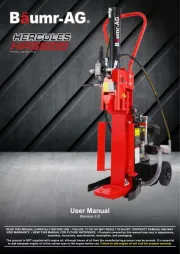
15 Augustus 2025
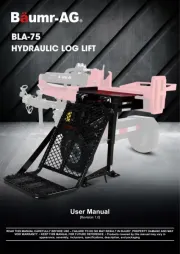
13 Augustus 2025
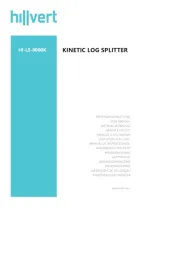
16 Juli 2025
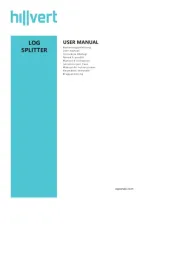
15 Juli 2025
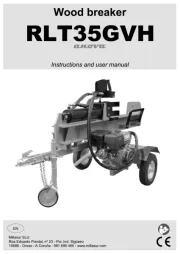
14 Juli 2025
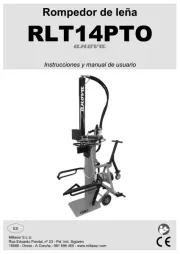
2 November 2024

5 September 2024

5 September 2024

5 September 2024

5 September 2024